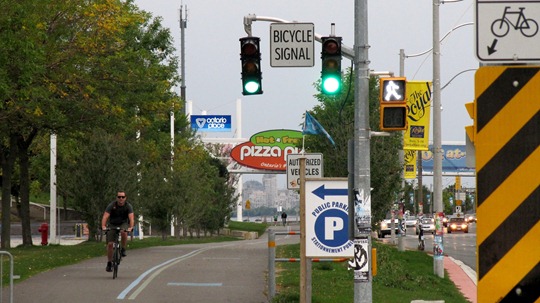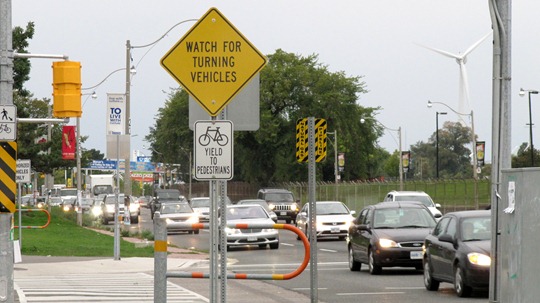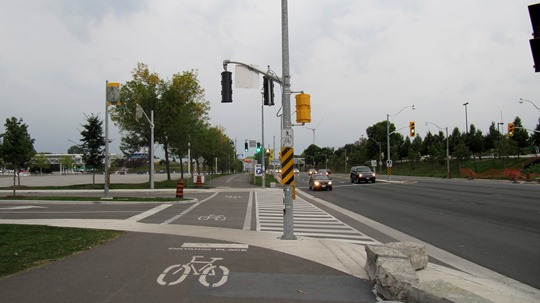Photo by James D. Schwartz / The Urban Country
Toronto loves to take great ideas from cycling cities, and then implement them completely wrong. One good example – bike traffic signals.
Cities that are more bicycle-friendly implement bicycle traffic signals to reduce the probability of conflicts between motor vehicles and bicycles.
In New York, you can see in the following video I recorded earlier this year that left-turning vehicles are required to wait until bicycle traffic is stopped. This prevents cars from crossing in the path of bicycles.
* New York is far from a bicycle-friendly city, but they have made drastic improvements since Janette Sadik-Khan took the reigns of NYC’s Department of Transportation.
These signals are all over the Netherlands and Denmark to prevent right-turning automobiles from crossing bicycle traffic.
Here in Toronto, we have bicycle signals on some cycle tracks, but they are synchronized with the motor vehicle traffic signals and pedestrian signals, so there is little benefit to having them.
Furthermore, the onus is on bicyclists and pedestrians to watch out for turning automobiles – not the other way around.
I couldn’t find a sign to warn drivers to watch for bicycles and pedestrians. But then again, most motorists probably wouldn’t see it while being distracted by changing radio stations, text messaging, drinking coffee and applying makeup.
These distracted motorists must first cross the pedestrian path and then the bicycle path. This is extremely dangerous because it’s very hard for motorists to see bicycles approaching the intersection – especially if they are riding at a good speed.
Here is a shot from further back – approaching cyclists are in the driver’s blind spot:
Here’s a video that shows bicycles crossing a Netherlands intersection – free of turning automobiles (in the rain no less):
And David Hembrow recently posted the following video on his blog that explains how junctions in the Netherlands are designed to prevent conflict between motorists and bicyclists:
Reducing conflict between automobiles and bicycles helps to make urban utility cycling more comfortable and safe. There are plenty of great ideas out there that we can implement here in North America with just a little bit of political will.
Do your part to convince your local politicians to implement infrastructure that makes bicycling safer and more enjoyable.
James D. Schwartz is the editor of The Urban Country. You can contact James at james.schwartz@theurbancountry.com.
Related Articles:
- Pragmatism Eludes Politicians (Feb 2010)
- A Beautiful Morning in Toronto (June 2010)
- Biking the Big Apple (March 2010)
- The Bike Path That Almost Was (Jan 2010)





You had me at the first line: “Toronto loves to take great ideas from cycling cities, and then implement them completely wrong.”
Some examples:
– limited implementation of Bixi
– limited ploughing of bike lanes/paths
– ‘safety’ blitzes against the vehicles which harm the fewest, not the most
– unenforced bike lanes
– little policing of bike theft.
– and so many more!
Having been a winner of a “right hook” at the intersection pictured above while entering that intersection on a green, (from the opposite direction) the city does implement things backwards. Those bicycle signals do more harm than good and should be removed.
At that intersection, there is a sign high up on a post (almost unnoticeable) for right turning cars warning turning cars to “watch for bicycles”. Most interesting is the disproportinate size of the sign for the slower moving bicycles/pedestrians warning them to “watch for turning vehicles” in comparison to the sign warning speeding motorists.
Best of all the driver that hit me was an employee of Ontario Place and should have known that this trail is used year-round by cyclists and pedestrians. Just wait until some visitor to Ontario Place takes out a family on a weekend ride.
The problem with having separate phases is that it slows everyone down. So instead of bikes having 20 seconds of green, suddenly you have 9 seconds of green. Same with the turning cars. Instead of 20 seconds of turning time (yielding to bikes and pedestrians) you have 10 seconds.
A better solution is to have the side path merge with the road at intersections.
The turning cars could use a sensor so if no cars are turning, then nobody is slowed down. Most of the time, no cars are turning right anyway – it’s only when there are events that a substantial number of cars would be turning. But the sensors could keep the right-turning light green for longer if there are more cars turning right.